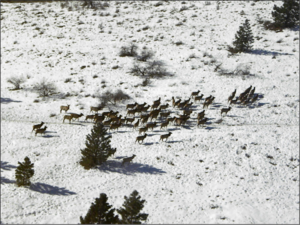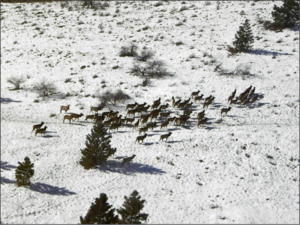
Even Tribal Hunters now can not be claiming that wolves are damaging their Deer and Elk Populations. Protect The Wolves™ has watchful eyes everywhere.
NESPELEM – Nearly across the board, the Colville Confederated Tribes Fish and Wildlife department big game counts showed record high number for adult mule deer, whitetail deer, elk and moose, though calf and fawn populations were down in early 2017.
CTFW’s Eric Krausz presented the 2017 Big Game Aerial Survey results to the Colville Business Council’s Natural Resource Committee, Tuesday.
The numbers are found using observed head counts made by CTFW employees during aerial flights in February along with computer models that take into consideration snow cover, animal activity, vegetation present and percentages of cover obscuring animals, according to Krausz.
Mule deer
The total number of mule deer observed increased from 1,890 in 2013, which was the last aerial flight conducted, to 2,720 in 2017.
This was the highest observed mule deer count on record since aerial surveys were first implemented in 1985, according to a publication that accompanied Krausz’s presentation. Previously, the record high-observed adult mule deer had been in 2007 with 2,693.
Mule deer fawn counts also increased from 497 in 2013 to 651 in 2017. However the ratio of fawns to adult deer had decreased from 36 fawns per 100 adult mule deer to 31 fawns per 100 adult mule deer.
According to Krausz, that average falls short of CTFW’s management goal of 40 fawns per 100 adults is desired.
Whitetail Deer
The total number of observed whitetail deer increased from 2,237 in 2013 to 2,497 in 2017. The adult numbers increased from 1,629 to 1,941 in the same years, however the number of observed fawns decreased from 608 to 556.
Although this was the third highest number of observed whitetail fawns recorded since aerial flights began in 1985, the ratio of fawns per 100 adults decreased from 37 to 29 fawns per 100 adults.
“Decreased white-tailed fawn survival is likely the result of both the direct influence of winter severity on the availability of forage as well as the indirect impact of deep snow offering predators an increased advantage,” reads the report. “Again, if this interpretation of the data is correct we should expect a decrease in overall adult numbers, specifically from this cohort, in the coming years.”
Elk
Like deer, the total observed elk increased while the calf to adult ratio decreased.
The total number of observed elk increased from 533 in 2013 to 792 in 2017, which is the highest number of observed elk on record.
Of that, bulls increased from 76 to 129 in the same time frame, and cows increased from 348 to 523.
Calves however increased only slightly, from 109 in 2013 to 140 in 2017, making the ratio 31 per 100 adults in 2013 and 27 per 100 adults in 2017.
“Elk continue to disperse across the Reservation, occupying new territories as they find new suitable habitat,” reads the report. “Several elk groups were observed wintering in new areas or at greater densities than had been observed in those areas during past surveys. Sub-units such as; 21 mile creek, 23 mile creek, and 25 mile creek, all experienced increased observed elk numbers. A small cow/calf/spike group was also observed for the first time in the No Name Creek Sub-unit located at the north end of Omak Lake.”
Computing modeling estimates the number of elk on the Colville Reservation at 1426, which is the highest it’s been since elk counting began in 2002 but which is also shy of the IRMP goal of 1,500 to 2,000 elk.
Moose
The exception in 2017, the total number of moose decreased from a record of 156 in 2013 to 124 in 2017, which is the second highest observed number of moose. Cow numbers decreased from 68 to 54, while bull numbers decreased from 49 to 42 in 2013 and 2017 respectively.
The ratio of calves to cows decreased slightly from 57 per 100 in 2013 to 52 per 100 in 2017.
Computer modeling estimated there to be 773 moose on the Colville Reservation, while the same modeling estimated 790 in 2013.
“Additionally, snow depth is not as limiting to moose as it is for deer or elk, allowing moose to use a much larger portion of the landscape during the winter months,
reads the report. “During the 2017 aerial census however, moose were observed at lower elevations than we would normally expect to see them, showing that winter conditions were severe enough to influence a species well adapted for such conditions. Snow conditions were ideal for winter surveys, providing the ideal background for observing moose from the helicopter.”
Bighorn sheep
In the Omak Lake Ridge Game Reserve, a total of 19 bighorn sheep in 2017, which included 7 ewes, 2 lambs, 10 rams. While in the Hellgate Game Reserve numbers decreased from 215 in 2015 to 152 in 2017, which included 81 ewes, 40 lambs and 31 rams.
Computing modeling estimated 47 big horn on the Omak Reserve and 220 in Hellgate.
“We do not anticipate any changes in the Hellgate bighorn sheep population at this time,” read the publication. “Observed lamb numbers were at a record high and we have not detected any disease events since the first re-introduction in 2009. It is likely that some animals were across the river during surveys or down river in areas we had not previously detected bighorn presence. As with the Omak Lake population, capturing and deploying GPS collars on a sub-sample of the Hellgate bighorn sheep will likely provide us with answers to our questions regarding exploratory animal movements and offer insight into any possible new areas providing adequate resources for sheep to inhabit adjacent to the Hellgate population.”
